|
Preah Sihanouk province
Preah Sihanouk (Khmer: ព្រះសីហនុ, UNGEGN: Preăh Seihânŭ, ALA-LC: Braḥ Sīhanu [preah səjhanuʔ], lit. 'Holy Sihanouk'), also Sihanoukville, is a province (khaet) in southwest Cambodia on the Gulf of Thailand. The provincial capital, also called Sihanoukville, is a deep water port city and a steadily growing and diversifying urban center on an elevated peninsula.[6] First established as Kampong Som (Khmer: កំពង់សោម, lit. 'The Som Rattan Port'), the province was later renamed in honor of former King Norodom Sihanouk, who orchestrated the establishment of Sihanoukville city and the Sihanoukville municipality as this took place alongside the construction of the Sihanoukville Port, which commenced in June 1955. The only deep water port of Cambodia, it includes an oil terminal and a transport logistics facility.[7][8] Preah Sihanouk is divided into four districts, each with a distinct economic character, defined largely by location and access to resources.[9] In addition to the port and the growing tourism industry, the activities of countless NGOs and international investment have contributed to the rapid economic growth of the province over the course of the last decade.[10] Primary economic sectors are transport and logistics, process manufacturing, agriculture and fisheries, textiles, and real estate. The islands and beaches of Preah Sihanouk Province are an international tourist destination as visitor numbers have risen steadily since the late-20th century.[11][12] Sihanoukville municipality was elevated to provincial status on 22 December 2008 after King Norodom Sihamoni signed a decree converting the municipalities of Kep, Pailin, and Sihanoukville into provinces, as well as incorporating Kompong Seila District.[13][14] As one of Cambodia's agriculturally and industrially most diverse provinces, its economic future has a solid basis, although the essential sectors of agriculture and tourism require strict and permanent administrative protection of local natural resources.[15][16][17] EtymologyThe official name in Khmer is: Khaet ('province') Preah ('holy') Sihanouk (name of the former king), which translates to, 'province of the holy Sihanouk' or 'honorable Sihanouk province'. It honors the former king Norodom Sihanouk (reigned 1941–1955 and 1993–2004) who was and still is revered as the "father of the modern nation".[18] Sihanouk himself suggested the official Western variant Sihanoukville. The name "Sihanouk" is derived from Sanskrit through two Pali words, sīha ('lion'), and hanu ('jaws'). The former name Kampong Som (also romanized as Kompong Som) (Khmer: កំពង់សោម) means 'Port of the Moon' or 'Shiva's Port'.[19] Som is derived from the Sanskrit word saumya, the original (Rig Vedic) meaning of which was Somā, the 'juice or sacrifice of the moon-god', but evolved into Pali 'moon', 'moonlike' 'name of Shiva'.[20] The word Kampong or Kompong is of Malayan origin[21] and means 'village' or 'hamlet'. Its meaning underwent extension towards 'pier' or 'river landing bridge'.[22] HistoryClassical period (before 1700)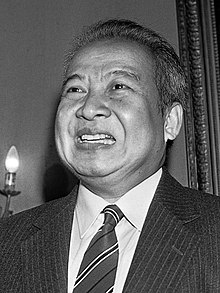 Prior to the city's creation in 1955, no recorded settlement on the peninsula existed that was larger than a traditional trading or fishing village. During the many centuries of pre-Angkorian and Angkorian history – from Funan to Chenla and during the Khmer Empire, regional trade was centered at O Keo (Vietnamese: Óc Eo) in the Mekong Delta, now the province of Rạch Giá in Vietnam. The township of Prei Nokor (Saigon) was a commercial center of the Khmer Empire.[23][24] The Chronicle of Samtec Cauva Vamn Juon – one of the 18th and 19th century Cambodian Royal Chronicles – briefly mentions the region as the country was split into three parts during a nine year civil war from 1476 to 1485: "In 1479, Dhammaraja took on the throne at Catumukh (Phnom Penh) and controlled the provinces of Samrong Tong, Thpong, Kompong Saom, Kampot up to the Bassak, Preah Trapeang, Kramuon Sar, Koh Slaket and Peam".[25] Early modern period (c. 1700–1863)From the end of the 17th century, Cambodia lost control of the Mekong River as Vietnamese power expanded into the lower Mekong. During the Nguyen-Siamese War (1717–1718) a Siamese fleet burned the port of Kompong Som in 1717 but was defeated by the Vietnamese at Banteay Meas/Ha Tien.[26] A Cambodian king of the late-18th century, Outey-Reachea III allied with a Chinese pirate,[27] Mac-Thien-Tu, who had established an autonomous polity based in Ha Tien and controlled the maritime network in the eastern part of the Gulf of Thailand.[28] Ha Tien was at a point where a river linking to the Bassac River flows into the Gulf of Thailand. Landlocked Cambodia tried to keep its access to maritime trade through Ha Tien. In 1757 Ha Tien acquired the ports of Kampot and Kompong Som as a reward for Mac's military support of the King of Cambodia. Until its destruction in 1771 the port developed into an independent duty-free entrepôt linked with several Chinese trading networks.[29] Alexander Hamilton, who traveled on the Gulf of Thailand in 1720, wrote that "Kompong Som and Banteay Meas (later Ha Tien) belonged to Cambodia, as Cochin-China was divided from Cambodia by a river (Bassac River) of three leagues broad." and "King Ang Duong constructed a road from his capital of Oudong to Kampot". Kampot remained the only international seaport of Cambodia. "The traveling time between Udong and Kampot was eight days by oxcart and four days by elephants." French Résident Adhemard Leclère wrote: "...Until the 1840s, the Vietnamese governed Kampot and Péam [Mekong Delta], but Kompong Som belonged to Cambodia. The Vietnamese constructed a road from Ha Tien to Svai village - on the border with Kompong-Som - via Kampot."[30] The British Empire followed a distinct policy by the 1850s, seeking to consolidate its influence. Eyewitness reports give rare insights, as Foreign Secretary Lord Palmerston's agent John Crawfurd reports: "Cambodia was...the Keystone of our policy in these countries, - the King of that ancient Kingdom is ready to throw himself under the protection of any European nation...The Vietnamese were interfering with the trade at Kampot, and this would be the basis of an approach..." Palmerston concluded: "The trade at Kampot - one of the few remaining ports, could never be considerable, in consequence of the main entrance to the country, the Mekong, with all its feeders flowing into the Sea through the territory of Cochin China The country, too, had been devastated by recent Siam - Vietnam wars. Thus, without the aid of Great Britain, Kampot or any other port in Cambodia, can never become a commercial Emporium." Crawfurd later wrote: "The Cambodians... sought to use intervals of peace in the Siam - Vietnam wars to develop intercourse with outside nations. The trade at Kampot which they sought to foster was imperiled by pirates. Here is a point where the wedge might be inserted, that would open the interior of the Indo-Chinese Peninsula to British Commerce, as the great River of the Cambodians traverses its entire length and even affords communication into the heart of Siam".[31] French rule (1863–1954)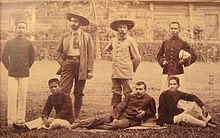 French civil servant Auguste Pavie (center) and Pierre Lefèvre-Pontalis in 1893 with Cambodian interpreters Under French rule Vietnam, Laos, and Cambodia became a single administrative and economic unit. The coastal region Circonscription Résidentielle with Kampot as its capital contained the arrondissements of Kampot, Kompong Som, Trang, and Kong-Pisey. The establishment of another international trading center near the existing city of Saigon was not considered necessary. Focus remained the Mekong, and the idea to establish an alternative route to Chinese and Thai internal markets along an uninterrupted navigable waterway from the Red River to the Mekong Delta. InsurrectionAn insurrection that took place from 1885 to 1887 further discouraged French ambition. It started in Kampot and quickly spread to Veal Rinh, Kampong Seila, and Kompong Som, where the insurgents were led by a Chinese pirate named Quan-Khiem. He managed to control the northern part of Preah Sihanouk for some time until he - an old man - was arrested by Preah Sihanouk's governor.[30] The most notable infrastructural improvements of this period were the construction of Route Coloniale No. 17, later renamed National Road No. 3 and the national railway system, although work on the "Southern Line" – from Phnom Penh to Sihanoukville – only began in 1960. After independence (since 1954)The province's alternative name Kompong Saom (Kampong Som) was adopted from the local indigenous community. After the dissolution of French Indochina in 1954, it became apparent that the steadily tightening control of the Mekong Delta by Vietnam required a solution to gain unrestricted access to the seas. Plans were made to construct an entirely new deep water port. Kompong Saom was selected for water depth and ease of access. In August 1955, a French/Cambodian construction team cut a base camp into the unoccupied jungle in the area that is now known as Hawaii Beach. Funds for construction of the port came from France and the road was financed by the United States.[32] During the Vietnam War the port became a military facility for both sides, in the service of National Front for the Liberation of South Vietnam and after 1970, under the government of Lon Nol, in the service of the United States.[33] The port was the last place to be evacuated by the US Army, only days before Khmer Rouge guerrillas took control of the government in April 1975. The events surrounding the taking of the US container ship SS Mayaguez and its crew on 12 May 1975 by the Khmer Rouge and the subsequent rescue operation by US Marines played out on the waters of Koh Tang off the coast of Sihanoukville. During the two days of action, the US struck at targets on mainland Sihanoukville including the port, the Ream Naval Base, an airfield, the railroad yard, and the petroleum refinery in addition to strikes and naval gun fire on several islands.[34] In 1993, Ream National Park was established by a royal decree of former King Sihanouk.[35] Sihanoukville Municipality was elevated to provincial status on 22 December 2008 after King Norodom Sihamoni signed a decree converting the municipalities of Kep, Pailin, and Sihanoukville into provinces.[36] On 26 May 2011 the Preah Sihanouk area joined the Paris-based club Les Plus Belles Baies Du Monde ('The most Beautiful Bays in the World'). The organisation officially accepts the Bay of Cambodia as one of its members at the 7th General Assembly.[37] Chinese investmentFrom 2013 to 2017, China has invested about US$1 billion annually in Cambodia, making it the largest foreign direct investor.[38] A significant share of that investment has been directed to Sihanoukville province. Chinese investments there are concentrated in a few key sectors such as casinos, real estate, resorts, and a deep-water port. Casinos are being built at such a fast pace that there is no agreement on how many there are: estimates range from 30 to 150.[38] Rising in concert with Chinese-owned buildings is the Chinese population of the province. Channel News Asia in late-2018 estimated that there were 78,000 Chinese residents and 120,000 Chinese visitors in Sihanoukville. The Cambodian population of the province is 150,000. The media—both national and international—have taken to calling Sihanoukville "China Town" or "Macau 2".[38] Geography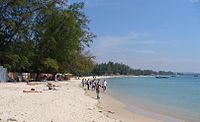 Preah Sihanouk Province is on the coast of the Gulf of Thailand in southern Cambodia, occupying an area of 2536 km2 that includes the foothills of the Elephant Mountains and a sizable peninsula. Moderately developed beaches, a national park and a number of islands in proximity are natural assets that attract national and foreign visitors. A small group of islands dot the near coast due south and west. Preah Sihanouk Province borders Koh Kong and Kampong Speu province to the north and west, Kampot province to the east, and the Gulf of Thailand to the south. The peninsula is separated from the central plains of Cambodia by the Elephant Mountains. The province incorporates Ream National Park, 210 km2, that includes the islands of Koh Thmei and Koh Seh.[39]  Being a comparatively small province, Preah Sihanouk Province has only two urban centers: Sihanoukville city itself and Veal Rinh in the Prey Nob District, 46 kilometers north of Sihanoukville town. Prey Nob District in the east is predominantly rural and agricultural. Stung Hauv District in the northwest, only half the size of Prey Nob, has the largest fisheries sector of the province. Kampong Seila District in the north is still in the process of incorporation. Mittakpheap District in the south about the size of Stung Hauv, including the islands of Sangkat Koh Rong is one of the most advanced settlement centers of Cambodia with a developed and versatile industry, a large pool of skilled work force and a high human development index. The province is connected to Phnom Penh by National Highway No. 4, to Kampot province by National Highway No. 3, and to Koh Kong province by National Highway No. 48. National Highway No. 4 is the southern end of Asian Highway 11, which is a section of the Asian Highway Network. Sihanoukville town: The town's layout reflects little urban planning. Neighborhoods accumulate around the major road Ekreach (English, 'independence'). BeachesSihanoukville's beaches are one of the province's most valuable economic resources with varying degrees of commercial exploitation. The beaches listed below do not include any of the island's beaches.  Casuarina tree
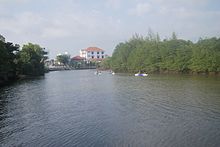 RiversThe mangrove lined Ou Trojak Jet river runs from Otres pagoda to Otres beach is the city's longest river popular with both canoeists and anglers, the lower section harbours a marina. Restaurants along the south bank of the river serve fresh seafood supplied by the local inshore fishing boats.  Islands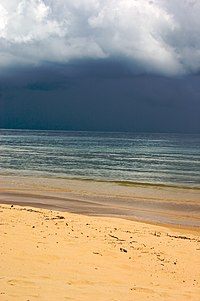 Twenty-two islands are administered by Preah Sihanouk Province. An increasing number are being developed for tourism. Koh Rong and Koh Rong Sanloem in particular have so far undergone years of unplanned development with many guesthouses and resorts.

Climate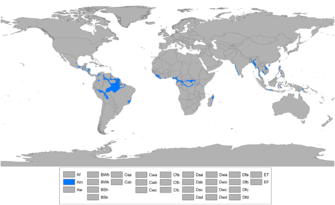 Sihanoukville lies in the tropical monsoon (Am) climate zone. It has two seasons: a wet season and a dry season. Monthly averages range from 14 °C (57.2 °F) in January to 36.0 °C (96.8 °F) in July. The maximum mean is about 30 °C; the minimum mean, about 24 °C. Maximum temperatures of higher than 32 °C (89.6 °F), however, are common and, just before the start of the rainy season, they may rise to more than 38 °C (100.4 °F). Minimum temperatures rarely fall below 20 °C (50 °F). January is the coolest month, and April is the warmest. Tropical cyclones cause much less damage in Cambodia than they do in Vietnam.[47] The total annual rainfall average is between 1,000 and 1,500 millimeters (39.4 and 59.1 in). The heaviest amounts fall in August and September. The relative humidity is high at night throughout the year; usually it exceeds 90%. During the daytime in the dry season, humidity averages about 50% or slightly lower, but it may remain about 60% in the rainy period.
Administration Sihanoukville used to be one municipality, holding the same status as a province. It was converted to a full province on 22 December 2008.[49] There is a provincial governor and three deputy governors. It is divided into three districts and three municipalities.[50] The port is autonomously administered.[51] The districts and municipalities are divided into 29 communes and 111 villages. Kampong Seila District, which belonged to Koh Kong province has, by royal decree, was transferred to Preah Sihanouk Province in January 2009: "The administrative boundaries of Preah Sihanouk municipality and Koh Kong province shall be adjusted by sub-dividing land from Kampong Seila district in whole and partial land of Sre Ambil district in Koh Kong province to Preah Sihanouk municipality." Officials were assigned to create a National Workshop - also in relation to other provinces - and process all necessary administrative tasks.[52] The National Institute of Statistics of Cambodia refers in its most recent and preliminary studies to a successful integration of the district, including maps,[53][54] although official statistics and numbers are expected to come with the next full report. Preah Sihanouk province's new official domain has incorporated Kompong Seila District.[55]  Sihanoukville Province districts: Mittakpheap (dark red), Stueng Hav (yellow), Prey Nob (blue), Kampong Seila (green)
Economy The economy of Sihanoukville province is varied but to a great part defined by its international port and the nearby oil port with numerous import-export companies settled in the area and the attached freight-transport sector with the local cargo storage facilities. Other sizable economic sectors of the province are fisheries, aquaculture, agriculture, mining, frozen shrimp processing, the garment industry, the real estate market, and tourism.[56] Sihanoukville is the home of Angkor Beer, one of Cambodia's major breweries. About US$1 billion was invested in the province by the Chinese between 2016–2018. As of 2019[update]. There are around 50 Chinese-owned casinos in the province, and dozens of new hotels are under construction, all aimed at the influx of Chinese tourists.[57]
Sihanoukville Special Economic Zone Sihanoukville's Special Economic Zone (SSEZ) as seen from National Highway No. 4 near Ream commune The Sihanoukville Special Economic Zone (SSEZ) is an economic and trade cooperation zone which was designed to promote favorable market conditions[59] such as: policy advantages, a safe political environment, favorable trade status, completed infrastructure, and cheap labor. In addition to its areas around the port, a sizable industrial center, exclusively composed of Chinese companies has been developed since around 2010.[60] Sihanoukville Autonomous PortThe Sihanoukville Autonomous Port has an independent administration. In combination with the related logistics and transport sector it is the city's economic backbone. At present, the total operational land area of the Sihanoukville Autonomous Port is around 124.76 ha. The Old Jetty was constructed in 1956 and became operational in 1960. The jetty is 290 m long by 28 m wide and can accommodate four vessels with medium GT at both sides. The exterior berth is -8.50 m to 13 m depth, while the interior berth is -7.50 m to -8.50 m depth. In order to cope with the increasing volume of cargo, the Royal Government of Cambodia had constructed another 350 m (1,148 ft) long new quay with −10.5 m (−34 ft) maximum draft in 1966. At present, this new quay can accommodate three vessels with −7 m (−23 ft) draft.[61] The construction of the container terminal, 400 m (1,312 ft) long by −10.5 m (−34 ft) depth and a 6.5 ha (16 acres) container yard was completed in March 2007.[62]
The Sihanoukville Autonomous Port was finished in 1960 as the international sea port of Cambodia. It has an area of 290 meters length and 28 meters width. Its exterior berth depth is 8.50 to 13 meters and 7.50 to 8.50 meters depth in the interior. Four medium vessels can simultaneously moor at the port.[51] The port is 18 kilometers (11 miles) from the Kaong Kang Airport and four kilometers (2 miles) from Sihanoukville town. Ships' passengers are allowed to visit Sihanoukville town. The terminal itself has no shopping center, banking or tourist offices, only toilets.[65]  AgricultureAs one of Cambodia's smallest provinces numbers of rice tonnage (37,211) are of little relevance for the annual statistics. Still Preah Sihanouk province has been able to diversify in subsidiary and industrial crops, fruits and permanent crops and incorporates fisheries (40,100 tons) into the sector.[64]
FisheriesAlthough the province is endowed with relatively abundant natural resources, protection thereof is of greatest significance. Pollution remains a concern particularly from trade vessels, domestic waste, and local industry. Resources are being indiscriminately diminished by illegal fishing via the neighboring countries. Seagrass beds and coral reefs are also under continued stress from over-exploitation and destructive activities.[66] The catching and processing of marine fisheries products is undertaken by both small-scale family style operations as well as on a large commercial level. Most coastal fishers lack the resources to procure suitable fishing equipment for coastal fishing. They, thus, tend to use small-scale fishing gear appropriate for inland use. The offshore net catch capacity of Cambodian fishers is relatively small compared to the available exploitation potential. The marine component of the fisheries sector in Cambodia is not nearly as important as that of the inland areas because of consumer preference for inland fish species. Sport fishing is popular with barracuda and marlin being the main target fish. Boats regularly operate from Otres Marina[67] TransportRoads and streets
 Streets in Sihanoukville town and province are in relative good condition. However, traffic does not obey traffic laws,[70] the police do little in the way of enforcement of international norms. Cambodia drives on the right. In urban and residential areas there is an abundance of motorbikes due to the absence of public transportation and taxis. Highways and Sihanoukville city are considered unsafe for driving. Drivers of motorbikes do not wear helmets, drive indiscriminately on either side of the street, do not have mirrors and it is common to see motorbikes with more than two passengers or vehicles driven by children and underage persons. Traffic lights are ignored altogether.[71] In 2008 the government ordered the enforcement of the use of helmets countrywide, but these rules are not yet followed.[72] The province does not have a scheduled public transportation system. Therefore, there exists an informal communal and urban transportation system of mini buses, taxis, motor-taxis (moto-dups) and tuk-tuks. This system is not administered by authorities, as anybody can become a bus, motor-taxi, or tuk-tuk driver. As a consequence, prices of services are ad-hoc, insurance non-existent, and service quality varies considerably.[73] Airport The province is served by Sihanouk International Airport, 18 kilometres (11 mi) from Sihanoukville town, although as of 2014 it sees limited commercial operation. The airport currently only schedules national passenger flights of Cambodia Angkor Air to Siem Reap and Phnom Penh. The airport's former name, Kaong Kang (កោងកាង, 'mangrove') reflects its site on top of a drained mangrove marsh by the sea in Ream commune in southern Sihanoukville province near National Highway 4. Buses and long-distance taxisLong-distance-buses start in Sihanoukville city near the port. Cambodia is home to many competing companies[74] that offer frequent services to all major provinces. Direct destinations are Phnom Penh, Koh Kong, and Kampot. Some companies offer services to Bangkok, Ho Chi Minh City, and Siem Reap through a connection in Phnom Penh. Marine transportThe last daily national official marine ferry service from/to Sihanoukville city to/from Krong Koh Kong ceased operation with the completion of National Highway 48 in 2007. Koh Rong and Koh Rong Sanloem have daily ferry service.[43] Access to smaller islands is generally provided by local holiday resorts, dive operators, the marina at Otres, or private operators. Additionally, small long-tail boats and medium size cruising boats can be hired for sightseeing, fishing, diving and drinking trips at the marina at Otres, guest houses, travel agencies and diving operators. Marina Oceania, the first marina in Cambodia, is operational and fully equipped since 2013 for yachts and boats up to 25 meters with 4-5 meter deep berths for 20 boats. It is at the local port's pier, near Koh Preab. (coordinates: 10° 39' 59" N / 103° 30' 41" E).[75] Holiday Cruise ships infrequently stop by at the port during their voyages in Southeast Asia.[76] RailThe railway network of Cambodia was re-constructed for freight transport by Toll Holdings, which has obtained a building and maintenance concession from the Royal Cambodian Railway.[77] The "Southern Line", constructed 1960-1969 with a length of 264 km, connects the Sihanoukville Port Special Economic Zone with the capital Phnom Penh. The currently rather deteriorated train station near the Autonomous Port used to manage passenger train transportation to Phnom Penh via Kampot before 1975. DemographicsThe 2008 census of Cambodia counted 199,902 inhabitants of Sihanoukville province.[78]
Khmer are the main ethnic group. In addition, there are other groups: Vietnamese, Chinese, Cham, Thai, French, British, Korean Europeans, Australians, and Americans, due to its status as an international port and a tourist destination. Krong Preah Sihanouk has a relative high Human Development Index (HDI) of 0.750 in average, compared to the national average HDI of 0.523.[80] According to a report in the Bangkok Post nearly 78,000 Chinese nationals live in the province in 2019, only 20,000 with official work permits. The influx has caused housing prices to soar.[81] Culture The majority of the province's inhabitants are of East Asian descent, which profoundly characterize and influence local customs, moral, commerce, cuisine, and tradition based on pan-East Asian beliefs and ideas. Cambodian culture is of distinct ancient Khmer origin, accompanied by century-old Chinese and Vietnamese cultural influences.[82] The prolonged presence of foreign and in particular Western people in Cambodia and Sihanoukville town contributes to a noticeable varied, modern, multi-cultural manifestation, which is increasingly influenced by modern media.[83] The inhabitants of Sihanoukville province celebrate all religious, traditional and secular festivities such as Cambodian New Year (April), Chinese New Year (between January and February), Water Festival (November), Pchum Ben (honor to the ancestors in October) and Kathen Ceremony (offerings to the monks), 8 January (Day of Cambodian - Vietnamese Friendship) among others. The ethnic and minority religious groups celebrate Christmas Day (25 December) and Holy Week for the Catholics, Ramadan for the Muslims, Valentine's Day and the International New Year (31 December). Many urban families of Chinese or Sino-Khmer descent[84][85] in Sihanoukville city have for most of Cambodia's history constituted the commercial elite and urban upper classes which was dominated by the ruling Cambodian People's Party (CPP). Besides the expressed Buddhist faith there is a strong dedication to Confucian work ethics, on commercial conduct and trade procedures while family bonds are very strong.[86][87] ReligionAs of 2004, there were 27 Theravada Buddhist pagodas in the province with a population of 1,918 monks.[88] Buddhist Pagodas are central in Cambodian culture as the defining spiritual source of villages and cities.
Sihanoukville province is also home to minor communities of other religions such as: Catholics, Muslims, Protestants and Taoists. Places of worship:
EducationPublic spending on education in Cambodia, totaled 2.60% (of GDP) as of 2010.[90] Cambodian general education is based on the national school curriculum that consists of: 1. Basic education The basic education curriculum is divided into three cycles of three years each. The first cycle (grade 1-3) consists of 27-30 lessons per week lasting 40 minutes which are allocated to five main subjects. The second cycle (grade 4-6) consists of the same number of lessons but is slightly different. The third cycle (grade 7-9) consists of 32-35 lessons which are allocated for seven major subjects.[91] 2. Upper secondary education The upper Secondary Education curriculum consists of two different phases. The curriculum for the first phase (grade 10) is identical to the third cycle of primary education. The second phase (grade 11-12) has two main components: Compulsory and Electives.[91] The total adult literacy rate of Sihanoukville is 95%.[92] The 2004 statistics[88] show the following centers of education: 33 pre-schools with 1,670 children, 52 primary schools with 34,863 students, five colleges with 4,794 students; two high schools with 1,449 students; 10 vocational training with 961 students, and 13,728 students in private schools. Private educational institutes in Sihanoukville are: Life University, University of Management and Economics, Built Bright University, Khmer Technology and Management Center, Don Bosco Technical School and Don Bosco Hotel School.
Sister citiesBibliography
References
External linksWikimedia Commons has media related to Sihanoukville Province. Government
Industry
Info, History & Geography |
|||||||||||||||||||||||||||||||||||||||||||||||||||||||||||||||||||||||||||||||||||||||||||||||||||||||||||||||||||||||||||||||||||||||||||||||||||||||||||||||||||||||||||||||||||||||||||||||||||||||||||||||||||||||||||||||||||||||||||||||||||||||||||||||||||||||||||||||||||||||||||||||||||||||||||||||||||||||||||||||||||||||||||||||||||||||||||||||||||||||||||||||||||||||||||||||||||||||||||||||||||||||||||||||||||||||||||||||||||||||||||||||||||||||||||||||||||||||||||||||||||||||||||||||||||||||||||||||||||||||||||||||||||||||||||||||||||||||||||||




















